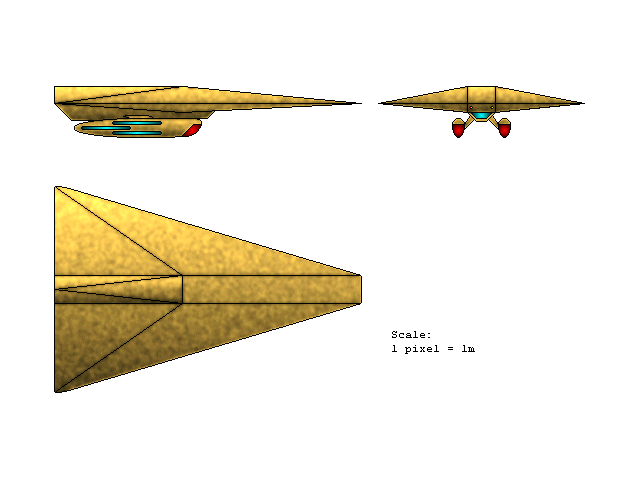

"Hiryu" class fast frigate
Inscription on Commissioning Plaque:
"There was a young woman named Bright
Whose speed was much faster than light.
She set out one day
In a relative way,
And returned on the previous night.."
-- (Anonymous)
Armaments: Ten phaser cannon coupled to the multifunction phased array; four quantum torpedo launchers (2 fwd, 2 aft); 1 squadron of 25 Semi-Autonomous Remotely-Piloted Expendable Vehicles (SARPEVs).
Type: Fast Frigate
Status: One undergoing shakedown, others to be produced once the quantum sliplstream propulsion system proves reliable.
About Ship: When Starfleet learned of the quantum slipstream (QS) technology discovered by the crew of the Voyager in the Delta quadrant, it immediately assigned a special team to determine how or if the advanced propulsion system could be produced by the Federation. Possession of such an advanced drive would give the Federation a significant military advantage over aggressive neighbors. More importantly, it would diminish the technology gap between the Federation and the Borg, an aggressor which already has the ability to travel at transwarp velocities.
The data provided by Voyager was sparse and sometimes contradictory, but it seemed as though the QS drive was an improved and debugged version of the transwarp drive originally installed in the U.S.S. Excelsior during the late 23d century. The QS drive had solved the three problems that had stymied Starfleet engineers a hundred years ago. Further analysis of the data suggested that Starfleet could possibly "backwards-engineer" the QS drive, using currently-available technology. The study team recommended a prototype be built to prove the technology.
The project was classified at the highest level and turned over to the Utopia Planitia shipyards. Starfleet engineers had a twofold problem getting the project underway, as they not only had to maintain secrecy but did not want to significantly disrupt construction at the facility, as this might call attention to the fact that their project was not an ordinary starship. They evaluated several designs currently under construction and decided to modify a dragon-class destroyer. The basic hull was very nearly the configuration their theories predicted for optimum slipstream flow around the vessel, and required very little modification to include the additional equipment necessary to create and stabilize a quantum slipstream conduit around the vessel. The new type vessel was named "Hiryu", Japanese for "flying dragon".
At first glance, the Hiryu class is very similar to the Dragon class, however, the Hiryu is approximately 20% smaller. The class vessel began as a partially-completed Dragon class hull. Internal differences are major. The main external differences are:
In addition to the systems mentioned above, the Hiryu is equipped with a multifunction phased array (MPA) and a PIMESS stealth system. The phaser cannons still feed their output to the MPA, but have been moved into the "wings" (in the space formerly allocated to the warp coils) to provide a more efficient use of available internal space. Rather than using internal rotary launch racks (as in the Dragon), the Hiryu utilizes four conventional torpedo launchers.
When completed, the Hiryu was conveyed to the proving grounds at Epsilon Tau. Performance under impulse and warp was much better than expected, and a significant improvement on the Dragon class. During initial trials, the QS drive worked considerably better than the transwarp drive of the Excelsior, but still exhibited excessive quantum shear stresses and time dilation effects. At first, this appeared to spell the end of the Hiryu class, but engineers quickly discovered that they could expand the volume of the "safe region" (the area within which shear stress is negligible) within the quantum slipstream conduit by rerouting some of the energy used to stabilize the conduit to the sides of the vessel via the MPA's emitters.
Another concern is that there is a small, but non-zero probability that a vessel using a QS drive may emerge from its conduit into another quantum reality than the one it originated from. Although this probability is quite low, Starfleet has issued a directive limiting the use of the QS drive to emergency situations until this problem is resolved. The Hiryu has provided Starfleet with invaluable experience with this new technology and is expected to enter production once its shakedown cruise is complete.
Return to the Starship Catalogue.